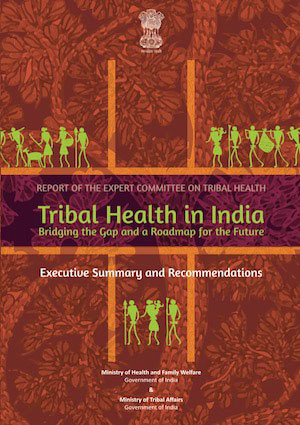Adivasis in India receive the “lowest-cost, poorest-quality and indifferently administered education”, a study backed by the UNICEF has revealed. Not only are the Adivasis marginalised, even affirmative action/reservation programmes for Adivasis (as Scheduled Tribes) in higher educational institutions have not had the desired effect, the report suggests.
Conducted by the National Institute of Advanced Studies, Bangalore, the study found that mainstream education has failed to recognise the aspirations, needs and predicament of Adivasis. The Naxal violence has made it worse, leading to “widespread destruction of Adivasi homes, livelihoods and larger support structure, including healthcare, schools and spaces for civic action”.
Submitted to UNICEF last week, the report is a broad perspective on Adivasi education in India noting the “systemic” marginalisation and ‘invisibilisation” of adivasi interests across political, policy and administrative levels. Indigenous adivasi culture, knowledge forms and language find no place in the dominant education system, it notes. […]
To correct the situation, the report recommends broad-based, inclusive policies paying specific attention to Adivasis, as well as streamlining and converging of parallel tribal-specific programmes.
Source: “UNICEF-backed study paints poor picture of Adivasi education” by Anubhuti Vishnoi, indianexpress.com, 28 August 2012
Address : http://m.indianexpress.com/news/%22unicefbacked-study-paints-poor-picture-of-adivasi-education%22/993978/
Date Visited: Tue Nov 13 2012 18:09:46 GMT+0100 (CET)
Tribal languages are a treasure trove of knowledge about a region’s flora, fauna and medicinal plants
“Tribal languages are a treasure trove of knowledge about a region’s flora, fauna and medicinal plants. Usually, this information is passed from generation to generation. However, when a language declines, that knowledge system is completely gone.” – Ayesha Kidwai (Centre for Linguistics, School of Language, Literature and Culture Studies, Jawaharlal Nehru University, New Delhi) quoted by Abhijit Mohanty in “Seven decades after independence, many tribal languages in India face extinction threat” | Learn more about the work done by the People’s Linguistic Survey of India and endangered languages worldwide >>
“The notion of ‘mainstreaming’ needs to be challenged not just because Adivasi culture is being crushed, but also because Adivasi values and ways of life offer insights that the ‘mainstream’ needs. If we are to halt the destruction of ecosystems, we need to understand how closely biodiversity and cultural diversity are intertwined. Perhaps it is time to reverse the gaze and begin to learn afresh from Adivasis.” – Felix Padel & Malvika Gupta (The Hindu) | Learn more about the role of tribal communities in fostering biodiversity, ethnobotany and cultural diversity | Success stories | Tribal identity >>
“I think that by retaining one’s childhood love of such things as trees, fishes, butterflies and … toads, one makes a peaceful and decent future a little more probable, and that by preaching the doctrine that nothing is to be admired except steel and concrete, one merely makes it a little surer that human beings will have no outlet for their surplus energy except in hatred and leader worship.” – George Orwell | Learn more: Childhood | Customs | Games and leisure time | Literature – fiction | Storytelling >>
“It was assumed that tribal people have same health problems, similar needs and hence the uniform national pattern of rural health care would be applicable to them as well, albeit with some alteration in population: provider ratio. The different terrain and environment in which they live, different social systems, different culture and hence different health care needs were not addressed.”– Abhay Bang, Chairman, Expert Committee on Tribal health (2018 Report of the Expert Committee on Tribal Health)
Learn more >>
Download Tribal Health in India PDF (35 MB) >>
Searchable file (backup):
PDF (OCR 70 MB) >>

Tip: click on any red marker for details on endangered languages in a particular region of India.
Please note: the facts and figures cited (via hyperlinks) links call for updates and fact checking >>
Cultural invisibility – India’s 600 potentially endangered languages | Linguistic Survey of India (official website) >>
Learn more
Adivasi Academy & Museum of Adivasi Voice at Tejgadh
Appropriate education for Adivasi children – the Vidyodaya School model
Childhood | Children’s books | Childrens rights: UNICEF India | Safe search
Childrens rights: UNICEF India
Convention on the Rights of the Child: The children’s version | Unicef
eBook | Background guide for education
eBook | Free resources for rural education and health care – Unicef
eBook | “Where the mind is without fear”: Tagore, Gitanjali and the Nobel Prize
Education and literacy | A View of Higher Education in India | Right to education
Forest Rights Act (FRA) | Illegal mining
Health and nutrition | Recommendations by the Expert Committee
Multi-lingual education & Central Institute of Indian Languages (CIIL)
Multilingual education is a pillar of intergenerational learning – Unesco
People’s Linguistic Survey of India | Volumes (PLSI) | PeoplesLinguisticSurvey.org
Rabindranath Tagore: a universal voice – Unesco
RSV School & Museum of Santal Culture (West Bengal)
Scheduled Tribes (ST) | Success story
Tribal Children’s Right to Education in India
Unesco | Unicef | Unicef India | United Nations
United Nations International Days and Weeks
Video | “Nations don’t make us human – languages make us human”: Ganesh Devy
Women | Safe search | President Droupadi Murmu on women’s empowerment